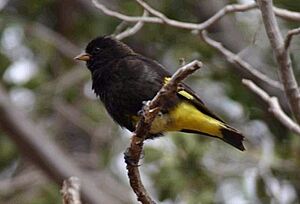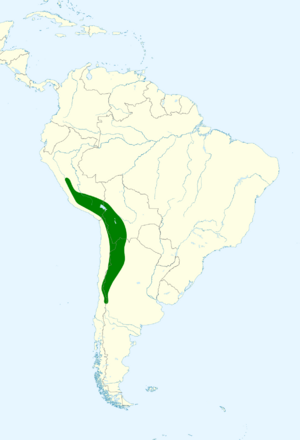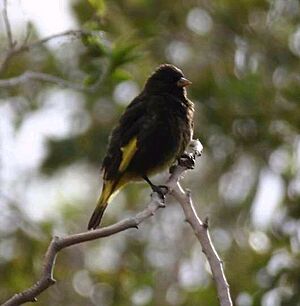Black siskin facts for kids
Quick facts for kids Black siskin |
|
|---|---|
 |
|
| Conservation status | |
| Scientific classification | |
 |
|
| Synonyms | |
|
The black siskin (Spinus atratus) is a small bird from the finch family, called Fringillidae. You can find these birds living in parts of Argentina, Bolivia, Chile, and Peru. They like to live in high places, like mountains, where there are lots of shrubs or grasslands.
About the Black Siskin
The black siskin grows to be about 13 centimeters (or 5 inches) long. The male birds are mostly shiny black. They have bright yellow patches near their wings and on their lower belly and tail.
Female black siskins look similar to males. However, their black feathers are not as shiny and look a bit more brownish.
It can sometimes be hard to tell the black siskin apart from another bird called the yellow-rumped siskin (Spinus uropygialis). When they are sitting still, it's easier to see the differences. But when they fly, both birds show yellow patches on their wings and rump, which can make them look very alike!
Where They Live and What They Like
This bird makes its home high up in the Andes Mountains in South America. You can find them from central Peru all the way down to northern Chile and western Argentina. They usually live at very high altitudes, between 3,500 and 4,500 meters (about 11,500 to 14,800 feet). In the southern parts of their home range, they sometimes live a little lower.
Black siskins love rocky slopes and deep valleys. They also like areas with tall, clumpy grass and small bushes, which are common in the Puna grassland region. You might even spot them living near people's homes!
These birds are often seen in pairs or small groups. Sometimes, they even join other types of finches. They usually look for food on the ground or in low bushes.
Is the Black Siskin Safe?
The black siskin has a very large area where it lives. It's also a fairly common bird, even though you might not see them everywhere. The number of black siskins seems to be staying steady. Because of this, the International Union for Conservation of Nature (IUCN) says that the black siskin is a "least concern" species. This means they are not currently in danger of disappearing.



